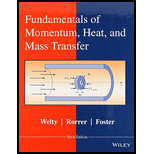
(a)
Interpretation:
For the uniform exit velocity, the value of mass flow rate and maximum velocity should be calculated.
Concept Introduction:
According to law of conservation of mass, energy can neither be created nor be destroyed.
The generalized form of equation is written as:
[Rate of mass in from control volume] - [Rate of mass out from control volume] + [Rate of accumulation]
Mass flow rate is defined as the ratio of the mass of fluid passing the point with respect to time.
Law of conservation of mass for control volume is given by,
Where,
t is the time.
Mass flow rate in terms of average velocity is,
Where,
A is the area.
v is the average velocity.
Maximum velocity is the velocity which exists at the center of circular passage. The relationship between average velocity and maximum velocity is,
(b)
Interpretation:
For the parabolic exit velocity,the value of mass flow rate and maximum velocity should be calculated
Concept Introduction:
According to law of conservation of mass, energy can neither be created nor be destroyed.
The generalized form of equation is written as:
[Rate of mass in from control volume] - [Rate of mass out from control volume] + [Rate of accumulation]
Mass flow rate is defined as the ratio of the mass of fluid passing the point with respect to time.
Law of conservation of mass for control volume is given by,
Where,
t is the time.
Mass flow rate in terms of average velocity is,
Where,
A is the area.
v is the average velocity.
The equation of parabolic velocity profile is given by,
Where,
Want to see the full answer?
Check out a sample textbook solution
Chapter 4 Solutions
Fundamentals of Momentum, Heat, and Mass Transfer
 Introduction to Chemical Engineering Thermodynami...Chemical EngineeringISBN:9781259696527Author:J.M. Smith Termodinamica en ingenieria quimica, Hendrick C Van Ness, Michael Abbott, Mark SwihartPublisher:McGraw-Hill Education
Introduction to Chemical Engineering Thermodynami...Chemical EngineeringISBN:9781259696527Author:J.M. Smith Termodinamica en ingenieria quimica, Hendrick C Van Ness, Michael Abbott, Mark SwihartPublisher:McGraw-Hill Education Elementary Principles of Chemical Processes, Bind...Chemical EngineeringISBN:9781118431221Author:Richard M. Felder, Ronald W. Rousseau, Lisa G. BullardPublisher:WILEY
Elementary Principles of Chemical Processes, Bind...Chemical EngineeringISBN:9781118431221Author:Richard M. Felder, Ronald W. Rousseau, Lisa G. BullardPublisher:WILEY Elements of Chemical Reaction Engineering (5th Ed...Chemical EngineeringISBN:9780133887518Author:H. Scott FoglerPublisher:Prentice Hall
Elements of Chemical Reaction Engineering (5th Ed...Chemical EngineeringISBN:9780133887518Author:H. Scott FoglerPublisher:Prentice Hall
 Industrial Plastics: Theory and ApplicationsChemical EngineeringISBN:9781285061238Author:Lokensgard, ErikPublisher:Delmar Cengage Learning
Industrial Plastics: Theory and ApplicationsChemical EngineeringISBN:9781285061238Author:Lokensgard, ErikPublisher:Delmar Cengage Learning Unit Operations of Chemical EngineeringChemical EngineeringISBN:9780072848236Author:Warren McCabe, Julian C. Smith, Peter HarriottPublisher:McGraw-Hill Companies, The
Unit Operations of Chemical EngineeringChemical EngineeringISBN:9780072848236Author:Warren McCabe, Julian C. Smith, Peter HarriottPublisher:McGraw-Hill Companies, The





